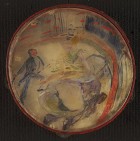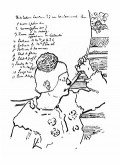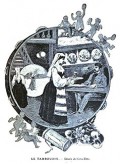The browser will either open the file, download it, or display a dialog.

Henri de Toulouse-Lautrec’s Au Cirque: Ecuyère (At the Circus: The Bareback Rider)
The Art Institute of Chicago has recently enriched its collection of works by Henri de Toulouse Lautrec by acquiring a tambourine painted in 1887 or 1888 (fig. 1)[1]—the time when the artist permanently broke with his academic training in the Atelier Fernand Cormon and launched himself publicly as a chronicler of Montmartre. At this same moment, and in contrast to his previous repertoire of portraits, landscapes, illustrations for the popular press, and paintings intended to serve as illustrations, he embarked on a huge multifigural composition of the popular Cirque Fernando (now lost) and the large painting in the Art Institute’s collection, The Equestrienne (fig. 2).[2] The latter soon also became Lautrec’s public manifesto and calling card, since it went on permanent public view in October 1889 in the foyer (for which it may have been commissioned) of the famous dance hall, the Moulin Rouge.[3]
The Cirque Fernando, the most proletarian of the three full-time indoor circuses in Paris, was known for its equestrian and trained animal acts. Like the café-concerts and dance halls, it provided Lautrec with a perfect spectacle of high and low life, combining the glittering glamour of the bareback rider and the dark elegance of the ringmaster with the comedic pathos of the clowns. These three components—rider, circus master and clown—reappear, in various combinations, in almost all of the artist’s circus works from this period, including the tambourine, encircled by the bands of red seats and black-clad ringside spectators.[4]
At least two of his circus works, one of which may be the Art Institute’s Equestrienne, were shown in February 1888 at the avant-garde venue of Les XX in Brussels. For this important debut, Lautrec made a special drawing of a mustachioed clown holding a paper hoop in which the titles of the eleven works he showed were written (fig. 3). In paintings and drawings, Lautrec exploited the hoop motif—as both the apparatus for the death-defying feat of the bareback rider, who must leap off the horse through it, and as a witty compositional conceit. In the Art Institute’s painting, the hoop echoes the equally rotund figure of the clown, both of which are radically cropped by the top of the picture. In the painted tambourine, the paper hoop is suggested by the tambourine itself, providing the illusion that the bareback rider, seated side-saddle and seen from behind, has just accomplished her feat so that we, the viewers, look through the hoop through which she has just broken.
Although sketchy and quickly brushed directly on animal skin, Lautrec created all the drama and excitement of the larger painting. The shape of the tambourine, into which Lautrec radically contorts his subjects, exaggerates even further the centrifugal energy of the horse as it skims the perimeters of the banded ring. The spectators, which in the painting on canvas are clearly men in the black and white uniform of the bourgeois male, are highly schematized into purplish-black hatchings in the upper right of the tambourine—a shorthand for expressing the crowds as if seen by the perpetually moving bareback rider, which the artist also used in a large vertical panel of a similar subject, presumably made as part of a decorative screen (fig. 4).
Lautrec’s choice of a support, a tambourine with little castanets known as a tambour de basque,[5] would not have been seen as unusual. Along with fans, tambourines—the traditional attribute of the bohemian gypsy—were popular objects for artists. Years after his trip to Spain, Manet painted at least seven tambourines with Spanish subjects, two of which were shown in December 1879 in the offices of La Vie Moderne, the vanguard literary and artistic journal, along with tambourines painted by a number of other well-known artists, including Jean-Léon Gérôme and William Bouguereau, as well as younger artists like Renoir.[6]
Closer to Lautrec’s circle in the mid-eighties was Vincent van Gogh, a fellow classmate at the Atelier Cormon, whose favorite haunt, the Café Tambourin at 62 Boulevard Clichy in Montmartre, was decorated with tambourine tables and chairs, with images of tambourines painted on the exterior walls, and with the actual painted instruments hung on the interior walls (fig. 5).[7] Like many eating and drinking establishments with a distinguishing theme (Divan Japonais, Bouillon le Chalet), it catered to an artistic crowd and in 1885, when it reopened at the foothills of the Butte Montmartre, it hosted an exhibition of paintings and painted tambourines by Gérôme, Alfred Besnard, and other established artists.[8] In 1887 Van Gogh painted its proprietress, La Segatori, with whom he had a brief relationship, at a tambourine-table, and that same year organized an exhibition of Japanese prints, thus bringing the two “other” influential cultures on vanguard art (Spain and Japan) together.[9]
Although Lautrec’s Au Cirque tambourine was probably an independent undertaking unrelated to the 1885 exhibition, his friendship with Van Gogh, whom he painted with a glass of absinthe at hand in 1887, would have put him in La Segatori’s orbit.[10] And just as he had decorated at least one fan and painted a large mural as well as a panel for a screen with the circus motif, taking on a tambourine would have been another way of challenging the tradition of oil painting on canvas. It is likely that Lautrec, known for his stock of outlandish costumes and accessories (clown, Japanese weaponry, kimonos), owned a tambour de basque as well.[11] It is even possible that his choice of this instrument was as much in keeping with the trendy Café Tambourin as it was a nod to Manet, whose posthumous exhibition in 1884 included four painted tambourines, also drawn from the compositions of some of his first important paintings.[12]
At the Art Institute the tambourine Au Cirque not only links the story of Van Gogh to the younger post-Impressionist but also speaks to another example of “found” object as art, the carved cabinet by Gauguin and Emile Bernard (the latter also a member of the “Peintres de Petits Boulevards” in the mid 1880s) in the adjacent gallery 241.[13] Both the cabinet and the tambourine give physical confirmation of the breakdown of the hierarchy of traditional painting on canvas and of the challenges to composition, technique, and even subject matter inherent in creating artworks from non-traditional formats and supports.
Gloria Groom
David and Mary Winton Green Curator of 19th Century European Painting and Sculpture,
The Art Institute of Chicago.
[1] For the object’s provenance, exhibition history, and publication history, see http://www.artic.edu/aic/collections/artwork/204686?search_id=5 (accessed August 10, 2011).
[2] In a June 1887 letter to his mother, Lautrec wrote that he was working on a large panel for the circus. See Herbert D.Schimmel, ed.,The Letters of Henri de Toulouse-Lautrec (Oxford and New York: Oxford University Press, 1990), 113, no. 142. This is likely the now-lost mural-size canvas of the Cirque Fernando mentioned by both Maurice Joyant and François Gauzi, close friends of the artist, and seen in a photograph taken around 1889–90 of the artist’s studio on the rue Caulaincourt. Maurice Joyant, Henri de Toulouse-Lautrec (Paris: H. Floury, 1926), 1:86; and François Gauzi, Lautrec et son temps (Paris: David Perret, 1954), 119. For the photograph, see Charles F. Stuckey, Toulouse-Lautrec: Paintings (Chicago: The Art Institute of Chicago, 1979), 125. The photograph is located at the Bibliothèque Nationale, Paris.
[3] Joseph Oller, the owner of the Moulin Rouge, purchased The Equestrienne in 1888. The dance hall itself opened on October 6, 1889, with the painting displayed in the foyer. See Reinhold Heller, Toulouse-Lautrec: The Soul of Montmartre (Munich and New York: Prestel, 1997), 57, 59.
[4] Other works from this period showing similar circus scenes include a long, vertical canvas (At the Circus: Clown, Private Collection), a pastel drawing (At the Circus Fernando, Rider on a White Horse, Norton Simon Art Foundation), and a watercolor fan (Circus Scene, Private Collection).
[5] See Claudie Marcel-Dubois, L'Instrument de musique populaire, usages et symboles: Musée national des arts et traditions populaires, 28 novembre 1980 – 19 avril 1981, exh. cat. (Paris: Ministère de la Culture et de la Communication, 1980), 165, no 329.
[6] The exhibition, which Armand Silvestre writing for La Vie Moderne described as “one of the great artistic events of the year,” took place on the 17th and 18th of December 1879. Organized by Emile Bergerat at the galleries of La Vie Moderne, these painted tambourines by well-known artists were sold to benefit the flood victims of Murcia. Armand Silvestre, “Le Monde des Arts,” La Vie Moderne, December 20, 1879, 580–581. See also Spanish Dancers by Manet, exh. cat. (New York: Wildenstein and Co., 1941), 2.
[7] “The decor had an Italian theme. The serving girls and Agostina Segatori wore Italian costumes. The tables were tambourines, the plates were porcelain tambourines, the lantern was a glass tambourine—there were tambourines everwhere.” Mariel Oberthur, Cafes and Cabarets of Montmartre (Salt Lake City: G. M. Smith, 1984), 56.
[8] John Grand-Carteret, Raphaël et Gambrinus; ou, L'art dans la Brasserie (Paris: L. Westhausser, 1886), 155–59. See also Oberthur, Cafes and Cabarets, 55–57.
[9] Leo Jansen, Hans Luijten, and Nienke Bakker, eds., Vincent Van Gogh: The Letters (Amsterdam, The Hague, and Brussels: Van Gogh Museum; Huygens Institute; Mercatorfonds, 2009), 4:175n5, no. 640; also at http://vangoghletters.org/vg/letters/let640/letter.html (accessed August 10, 2011). See also Bogomila Welsh-Ovcharov, Vincent van Gogh and the Birth of Cloisonism, exh. cat. (Toronto: Art Gallery of Ontario, 1981), 100–101.
[10] Despite the suggestion by Bogamila Welsh-Ovcharov in Vincent van Gogh and the Birth of Cloisonism, 100, and by Gale Murray in Toulouse Lautrec: The Formative Years, 1878-1891 (Oxford: Clarendon Press, 1991), 144, that Lautrec made this tambourine for the Café Tambourin, it is unlikely, given that the tambourine and its related painting are datable to 1888 and the fact that the café was under new ownership by 1887.
[11] See photographs in Georges Beaute, Toulouse-Lautrec vu par les photographes (Lausanne: Edita, 1988), 20–21, 26–28, 41.
[12] Ecole Nationale Supérieure des Beaux-Arts, Exposition des oeuvres de Édouard Manet (Paris: A. Quantin, 1884).
[13] For image, see http://www.artic.edu/aic/collections/artwork/188629?search_id=3 (accessed August 2, 2011).







